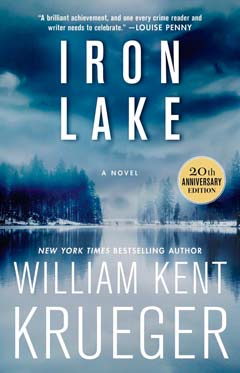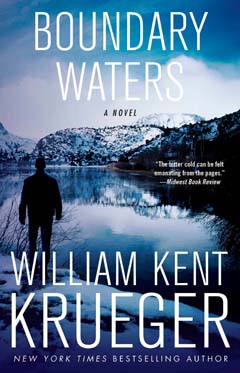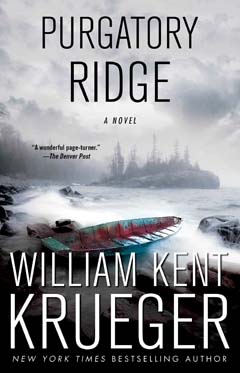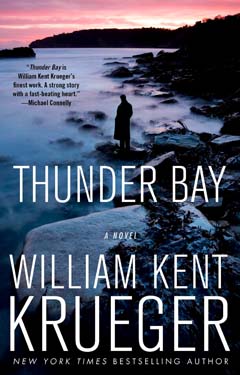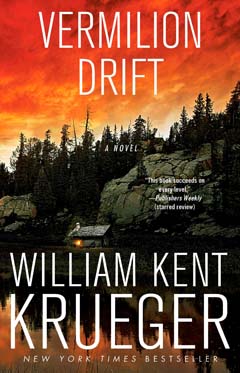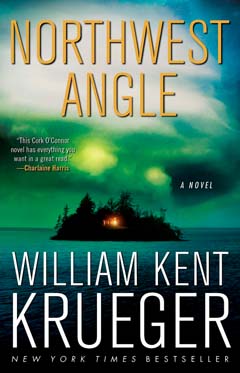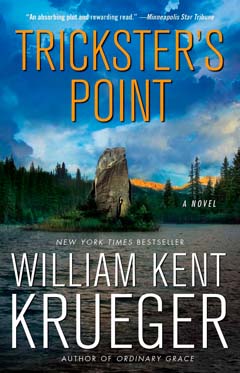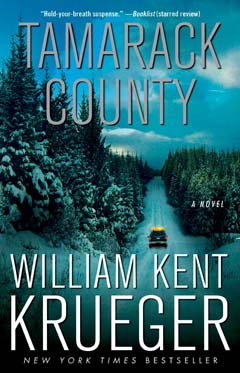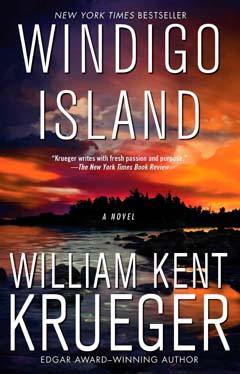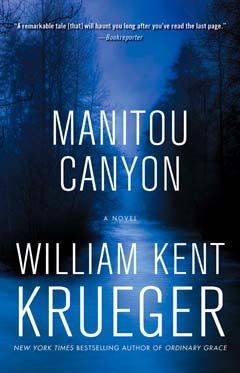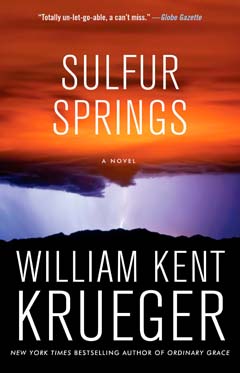A Cork O’Connor Mystery Novel – Book #10 | On Sale Now
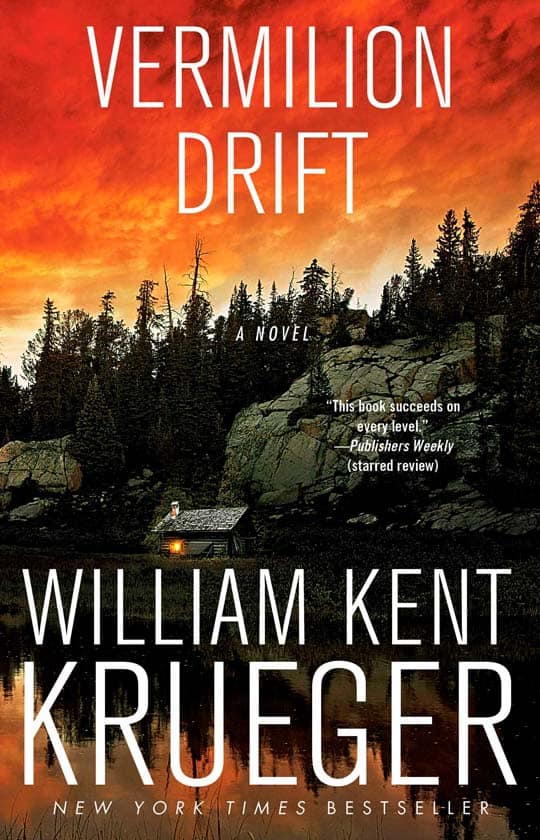
Order the Book
Atria Books Hardcover 2010, ISBN 978-1439153840
Atria Books Trade Paperback 2011, ISBN 978-1439153871
DESCRIPTION
A gripping tale of suspense that begins with Cork’s recurring nightmare of his father’s death, a gun, and a wound in the earth so deep and horrific that it has a name: Vermilion Drift.
William Kent Krueger’s gripping tale of suspense begins with a recurring nightmare, a gun, and a wound in the earth so deep and horrific that it has a name: Vermilion Drift.
When the Department of Energy puts an underground iron mine on its short list of potential sites for storage of nuclear waste, a barrage of protest erupts in Tamarack County, Minnesota, and Cork is hired as a security consultant.
Deep in the mine during his first day on the job, Cork stumbles across a secret room that contains the remains of six murder victims. Five appear to be nearly half a century old—connected to what the media once dubbed “The Vanishings,” a series of unsolved disappearances in the summer of 1964, when Cork’s father was sheriff in Tamarack County. But the sixth has been dead less than a week. What’s worse, two of the bodies—including the most recent victim—were killed using Cork’s own gun, one handed down to him from his father.
As Cork searches for answers, he must dig into his own past and that of his father, a well-respected man who harbored a ghastly truth. Time is running out, however. New threats surface, and unless Cork can unravel the tangled thread of clues quickly, more death is sure to come.
AWARDS
Nominee, Minnesota Book Award for Genre Fiction (2011), Friends of the Saint Paul Library
Nominee, Northeastern Minnesota Book Award (2010), University of Minnesota
PRAISE
“Krueger fans will find a feast in between these covers, and for those who have yet to sample his fine and evocative writing, the book offers a complex yet completely believable plot, all tied up in words sharpened by one of the modern masters of the craft.”
—Kirkus Reviews, starred review
“Krueger’s superlative 10th novel… succeeds on every level and ought to attract the author a deservedly wide readership.”
—Publishers Weekly, starred review
“For someone who writes such muscular prose, Krueger has a light touch that humanizes his characters…According to this writer’s code, a hero is allowed to break down and cry, and even a murderer can die with dignity.”
—The New York Times
“Crafty Minnesota PI Cork O’Conner is hired to find a missing woman and determine who’s sending death threats to people connected with the Vermilion One mine. While excavating for clues, Cork finds the remains of six bodies. Five may have been there since 1964; the sixth was murdered a week ago. Vermilion herrings may send readers off the trail, but the surprise ending makes this novel a worthwhile find.”
—People Magazine (Three Stars)
“Longtime fans of Krueger will find their loyalty more than rewarded with Vermilion Drift, while readers who are new to the series will find this installment the perfect place to jump on. As for Krueger, it may be necessary for him to interrupt the writing of his next mystery just long enough to make some additional room over his fireplace. I have the feeling he is going to need it.”
—Bookreporter.com
“Krueger is both literate and literary in all of his writing and this tenth O’Connor novel is no exception, filled with characters readers have come to care about, a timely and compelling plot, and a satisfying conclusion. It should be on the list of everyone who loves a well-told tale—and isn’t that all of us?”
—Deadly Pleasures (rating: A)
“Krueger’s novels featuring Cork O’Connor are beautifully written and deeply moving. Despite being miles apart in their settings, I’ve always thought Krueger has a lot in common in style and sentiment with James Lee Burke. Whereas Burke is a master of the Southern gothic crime novel, Krueger is rooted in what I’d call Northwoods gothic.”
—Milwaukee Journal Sentinel
“Filled with mystery and suspense as well as interesting characters, this book was a great read.”
—The Oklahoman (Oklahoma City, OK)
“Well written and a suspenseful tale… with good dialogue, a captivating and shocking story, and some twists to keep you glued to the pages. Highly recommended.”
—RT Book Reviews
“Can a writer keep getting better and better? Minnesotan William Kent Krueger surely can, as shown by Vermilion Drift, 10th in his award-winning series featuring former Sheriff Cork O’Connor. Krueger’s talent is in blending O’Connor’s personal life with intricate mysteries, enhanced by lyrical descriptions of northern Minnesota’s landscape. He excels in Vermilion Drift…Vermilion Drift deserves the starred reviews it earned from Publishers Weekly and Kirkus.”
—St. Paul Pioneer Press
“While Krueger frequently takes on topical issues, Vermilion Drift is his best yet, dealing with how we as a community and individuals dispose of unwanted things, whether it be nuclear waste or difficult memories.”
—StarTribune (Minneapolis, MN)
EXCERPT
Prologue
Some nights, Corcoran O’Connor dreams his father’s death.
Although the dream differs in the details, it always follows the same general pattern: His father falls from a great height. Sometimes he stumbles backward over a precipice, his face an explosion of surprise. Or he’s climbing a high, flat face of rock and, just as he reaches for the top, loses his grip and, in falling, appears both perplexed and angry. Or he steps into an empty elevator shaft, expecting a floor that is not there, and looks skyward with astonishment as the darkness swallows him.
In the dream Cork is always a boy. He’s always very near and reaches out to save his father, but his arm is too short, his hand too small. Always, his father is lost to him, and Cork stands alone and heartbroken.
If that was all of it, if that was the end of the nightmare, it probably wouldn’t haunt him in quite the way that it does. But the true end is a horrific vision that jars Cork awake every time. In the dream, he relives the dream, and in that dream revisited something changes. Not only is he near his father as the end occurs, but he also stands outside the dream watching it unfold, a distanced witness to himself and to all that unfolds. And what he sees from that uninvolved perspective delivers a horrible shock. For his hand, in reaching out, not only fails to save his father. It is his small hand, in fact, that shoves him to his death.
Chapter 1
That early June day began with one of the worst wounds Cork O’Connor had ever seen. It was nearly three miles long, a mile wide, and more than five hundred feet deep. It bled iron.
From behind the window glass of the fourth-floor conference room in the Great North Mining Company’s office complex, Cork looked down at the Ladyslipper Mine, one of the largest open-pit iron ore excavations in the world. It was a landscape of devastation, of wide plateaus and steep terraces and broad canyons, all of it the color of coagulating blood. He watched as far below him the jaws of an electric power shovel gobbled eighty tons of rock and spit the rubble into a dump truck the size of a house and with wheels twice as tall as a man. The gargantuan machine crawled away up an incline that cut along the side of the pit and immediately another just like it took its place, waiting to be filled. The work reminded him of insects feeding on the cavity of a dead body.
At the distant end of the mine, poised at the very lip of the pit itself, stood the town of Granger. The new town of Granger. Thirty years earlier, Great North had moved the entire community, buildings and all, a mile south in order to take the ore from beneath the original town site. Just outside Granger stood the immense structures of the taconite plant, where the rock was crushed and processed into iron pellets for shipping. Clouds of steam billowed upward hundreds of feet, huge white pillars holding up the gray overcast of the sky.
Although he’d viewed the mine and the work that went on deep inside many times, the sight never ceased to amaze and sadden him. The Ojibwe part of his thinking couldn’t help but look on the enterprise as a great injury delivered to Grandmother Earth.
“Cork. Good. You’re here.”
Cork turned as Max Cavanaugh closed the door. Cavanaugh was tall and agreeable, a man who easily caught a lady’s eye. In his early forties, he was younger than Cork by a decade. He was almost the last of the Cavanaughs, a family whose name had been associated with mining since 1887, when Richard Frankton Cavanaugh, a railroad man from St. Paul, had founded the Great North Mining Company and had sunk one of the first shafts in Minnesota’s great Iron Range. Cork saw Max Cavanaugh at Mass every Sunday and in winter they both played basketball for St. Agnes Catholic Church—the team was officially called the St. Agnes Saints, but all the players referred to themselves as “the old martyrs”—so they knew each other pretty well. Cavanaugh was normally a guy with an easy smile, but not today. Today his face was troubled, and with good reason. One of his holdings, the Vermilion One Mine, was at the center of a controversy that threatened at any moment to break into violence.
The two men shook hands.
“Where are the others?” Cork asked.
“They’re already headed to Vermilion One. I wanted to talk to you alone first. Have a seat?”
Cork took a chair at the conference table, and Cavanaugh took another.
“Do you find missing people, Cork?”
The question caught him by surprise. Cork had been expecting some discussion about Vermilion One. But it was also a question with some sting to it, because the most important missing person case he’d ever handled had been the disappearance of his own wife and that had ended tragically.
“On occasion I’ve been hired to do just that,” he replied cautiously.
“Can you find someone for me?”
“I could try. Who is it?”
The window at Cavanaugh’s back framed his face, which seemed as gray as the sky above the mine that morning. “My sister.”
Lauren Cavanaugh. Well known in Tamarack County for her unflagging efforts to bring artistic enlightenment to the North Country. Two years earlier, she’d founded the Northern Lights Center for the Arts, an artists’ retreat in Aurora that had, in a very short time, acquired a national reputation.
“I thought I read in the Sentinel that Lauren was in Chicago,” Cork said.
“She might be. I don’t know. Or she might be in New York or San Francisco or Paris.”
“I’m not sure I understand.”
“Is what I tell you confidential?”
“I consider it so, Max.”
Cavanaugh folded his hands atop his reflection in the shiny tabletop. “My sister does this sometimes. Just takes off. But she’s always kept in touch with me, let me know where she’s gone.”
“Not this time?”
“Not a word.”
“Nothing before she left?”
“No. But that’s not unusual. When she gets it into her head to go, she’s gone, just like that.”
“What about Chicago?”
He shook his head. “A smoke screen. I put that story out there.”
“Is her car gone?”
“Yes.”
“When did you last hear from her?”
“A week ago. We spoke on the phone.”
“How did she sound?”
“Like she always sounds. Like sunshine if it had a voice.”
Cork took out the little notebook and pen that he generally carried in his shirt pocket when he was working a case. He flipped the cover and found the first empty page.
“She drives a Mercedes, right?”
“A CLK coupe, two-door. Silver-gray.”
“Do you know the license plate number?”
“No, but I can get it.”
“So can I. Don’t bother.”
“She hasn’t charged any gas since she left.”
“How do you know?”
“I oversee all her finances. She also hasn’t charged any hotel rooms, any meals, anything.”
“Any substantial withdrawals from her bank account before she left?”
“Nothing extraordinary.”
“Is it possible she’s staying with a friend?”
“I’ve checked with everyone I can think of.”
“Have you talked to the police?”
“No. I’d rather handle this quietly.”
“You said she does this periodically. Why?”
Cavanaugh looked at Cork, his eyes staring out of a mist of confusion. “I don’t know exactly. She claims she needs to get away from her life.”
As far as Cork knew, her life consisted of lots of money and lots of adulation. What was there to run from?
“Is there someplace she usually goes?”
“Since she moved here, it’s generally the Twin Cities or Chicago. In the past, it’s been New York City, Sydney, London, Buenos Aires, Rome.”
“For the museums?”
He frowned. “Not amusing, Cork.”
“My point is what does she do there?”
“I don’t know. I don’t ask. Can you find her?”
“From what you’ve told me, she could be anywhere in the world.”
He shook his head. “She left her passport.”
“Well, that narrows it down to a couple of million square miles here in the U.S.”
“I don’t need your sarcasm, Cork. I need your help.”
“Does she have a cell phone?”
“Of course. I’ve been calling her number since she left.”
“We can get her cell phone records, see if she’s called anyone or taken calls from anyone. Did she pack a suitcase?”
“No, but sometimes when she takes off, she just goes and buys whatever she needs along the way.”
“According to her credit card records, not this time?”
“Not this time.”
“Does she use a computer? Have an e-mail account?”
“Yes.”
“Any way to check her e-mails?”
“I already have. There’s been no activity since last Sunday, and nothing in the communication before that that seems relevant.”
“Is it possible she has an account you don’t know about?”
“It’s possible but not probable.”
“How did you manage to get her e-mail password?”
“We’re close,” he said, and left it at that.
“Look, Max, there’s something I need to say.”
“Say it.”
“I have two grown daughters and a teenage son. It strikes me that I have less control, less access to their private lives than you have with your sister. Frankly, it seems odd.”
Cavanaugh stared at him. His eyes were the hard green-brown of turtle shells. Cork waited.
“My sister is flamboyant,” Cavanaugh finally said. “She inspires. She walks into a room and the place becomes electric, brighter and more exciting. People fall in love with her easily, and they’ll follow her anywhere. In this way, she’s charmed. But she has no concept of how to handle money. The truth is that financially she’s a walking disaster. Consequently, for most of her life, I’ve overseen her finances. It hasn’t been easy. There have been issues.”
“Recently?”
He hesitated. “This arts center of hers. She gifted it significantly from her own resources—our resources. The idea was that other avenues of financing would then be found. They haven’t materialized. I’ve been bleeding money into this project for some time now.”
“Do you have the ability to bleed?”
“There’s plenty of money. That’s not the point.”
“The point is her unreliability?”
He considered Cork’s question, as if searching for a better answer, then reluctantly nodded.
“One more question. Has your sister received any threats related to the situation at Vermilion One?”
“No. She’s not associated with this at all. The mine is my business.”
“All right.” Cork quoted his usual daily rate, then added, “A five-thousand-dollar bonus if I find her.”
“I don’t care what it takes. Will this interfere with your investigation of the mine threats?”
“I’m sure I can handle them both. I’ll prepare the paperwork. Will you be around this afternoon?”
“I have a meeting until four, but I’ll be at my home this evening.”
Cork said, “I’ll drop by. Say around six?”
“Thanks, Cork. But I’m hoping you’ll begin this investigation immediately.”
“I’m already on the clock.”
DISCUSSION GUIDE
Vermilion Drift
Introduction
On the Iron Range in northern Minnesota, private investigator Cork O’Connor has his hands full protecting a client’s mining company from protesters angry at its plan to store nuclear waste. But then a local socialite disappears and a secret mine tunnel unearths a collection of bodies that have been dead for decades, and things get more complicated. Suddenly O’Connor finds himself involved in a murder investigation that stretches back to a previous generation, which leads to surprising discoveries about his own family history.
Questions and Topics for Discussion
1. The prologue begins with O’Connor’s dream of pushing his father to his death. Why did the author begin the story this way? What did this recurring dream foreshadow in the story?
2. Cork O’Connor, in his mid-fifties, is a tough-nosed guy not afraid to ask hard questions. But how does his tack change in dealing with missing Lauren Cavanaugh as compared to the investigation of the bodies in the mine?
3. Does O’Connor consider himself part of the Anishinaabe tribe? If so, why is he so calm when he’s threatened and despised by Isaiah Broom and other members of the tribe?
4. Was O’Connor a traitor, as some felt, for working as a security consultant at the mine? Though he was friends with mine employees, they were looking for a place to store nuclear waste, which upset many. How would you have felt? Would you protect the mine, even if you disagreed with what they were working on?
5. O’Connor is well versed in the history of the Iron Range and his hometown. How does that inform how he handles the case and the people involved? What examples show how his insider knowledge helped him uncover aspects of the case?
6. What was your initial reaction to Derek Huff, the artist living at Lauren Cavanaugh’s artists’ retreat? What were your first thoughts about their possible relationship? Did it turn out to be correct?
7. Why was Ophelia so protective of Lauren and her living quarters? If she was just an employee of the artists’ commune, why was she concerned?
8. With O’Connor’s wife dead and his children away from home, what is his view of Aurora, his hometown? Consider this in context to his words, “And of what value, in the end, was a memory?” (page 61).
9. Henry Meloux is coy about helping O’Connor; why isn’t he more forthright in helping O’Connor understand the history of the Vanishings? What lesson is he trying to teach?
10. What is the importance of O’Connor’s mother’s journals? Why did someone go through the trouble of tearing out pages, and why was that information so important?
11. O’Connor often thinks of his father, and in many ways appears to be very much like him. How are his policework and personal beliefs affected by his father? How did his view of his dad change after he learned about his knowledge of the Vanishings?
12. Meloux described Indigo Broom and Monique Cavanaugh as people without souls, who had no choice but to be evil. What do you think of that philosophy? Did these people have a choice to do what was right, or were they destined for evil?
13. What are your feelings about the relationship between Max and Lauren? If she was so difficult to deal with, why was he so willing to help?
Enhance Your Book Club
1. Have you ever seen an iron mine? Do some research about them or go and visit one nearby. Could you handle going half a mile underground?
2. Like Hattie Stillday and some of the other artists at the retreat, use your skills to shoot some landscape scenes from your neighborhood.
3. O’Connor learns a lot about his family’s own past in the story. Did anyone in your family keep a journal? If so, see what stories you can glean from your family’s history. If not, why not start writing your own?
4. O’Connor enjoyed nothing more than having a cold Leinenkugel’s beer to end the day. Tip back a cold one as you discuss the story.
A Conversation with William Kent Krueger
Where did you get the idea for this story? Does any of it come from real events?
For a very long time, I’ve wanted to write a story that would allow me to highlight the unique history and culture of the area in northern Minnesota known as the Iron Range. I’ve also wanted to explore more significantly than I have in the past Cork’s relationship with his mother and father. These were the people who shaped the man Cork O’Connor has become. and I wanted to know more about them.
So, these ideas were part of the inspiration. The other part came from a scary but real possibility facing the Iron Range in the early 1990s. For a very brief period, there was significant interest in using the Soudan underground ,ine in Tower, Minnesota, as a site for storage of nuclear waste. Fortunately the idea was scrapped, but I resurrected the situation for Vermilion Drift.
You did a lot of research about the Iron Range and mining. How much time did you actually spend in the mines Vermillion Drift was based on?
With any book, I begin first with a good deal of reading research. Vermilion Driftwas no exception. I read everything I could about iron mining on the Range, both underground and in pits. But this kind of research can take you only so far. When I had what I thought was a good grasp of the generalities of iron mining, I made arrangements for a private tour of the Soudan mine, an abandoned underground iron mine that has become a Minnesota state park. I spent most of a morning touring the lowest level of that mine, an experience that gave me a greater appreciation and admiration for the men who spent their lives extracting iron in near-dark conditions. Over the years, I’ve visited the open-pit mines on the Range a number of times, but I was glad finally to have an opportunity to study them more carefully, with an eye to including them in the story.
Your main character resides in Minnesota; why do you choose to focus your novels on this part of America? Is that because that’s where you currently live? Would you consider writing a book set in another location?
The primary reason I set my work in northern Minnesota is because it’s one of the most intriguing and beautiful areas I know. I love this part of the country. The land is amazing, all forest and fresh water and dramatic geology. The people are a wild mix of nationalities and ethnic backgrounds. The politics are independent and all over the place. Before I began the Cork O’Connor series, I’d tried writing about other settings, without much success. I’m certain that my love of the North Country is a significant element in what makes my writing come alive.
A large part of the novel is the relationship between the Anishinaabeg and local people. How closely do the novel’s events compare to that of real life?
The Anishinaabeg, or Ojibwe, have always been at odds, one way or another, with the white community in Minnesota. Over the years, they’ve suffered greatly at the hands of greedy land grabbers and shady politicians. They constantly battle to maintain the rights granted them in treaties. And they battle as well the stereotypes about native people that a lot of whites still believe in. As a result, there’s often mistrust between the two groups, white and Ojibwe. The tense and often tenuous relationship I try to portray isn’t fiction.
The novel discusses bad spirits, sweat lodges, and other parts of Indian tradition. Do you indentify at all with those beliefs?
I’d be a damned fool not to believe in the possibilities.
On your website you talk about a number of blue-collar jobs you’ve had over the years, as well as run-ins with police as a college student. How do those events color your writing, especially when it comes to Cork O’Connor?
In my wild and wildly antiauthoritarian youth, I believed, as did many who came of age in the turbulent 1960s, that cops were brutal, mindless enforcers of unjust laws. Thank God that the years since have mellowed me and given me a broader perspective. In my research for the books, I’ve talked to a lot of men and women in law enforcement. They have been, without exception, bright, dedicated, and skilled in their work. As a result, I try to bring to my stories a wiser sensibility about the people who enter this difficult, very necessary profession. As for Cork himself, he’s a down-to-earth kind of guy, and in many ways he reflects the respect I gained for working stiffs during all those years I was one myself.
Now that you’re a full-time writer, were there things you preferred about having a regular job and writing on the side?
Not a single one that I can think of. This is the best job ever!
You blogged about rereading your own work and how you viewed it years later. How did that process affect you and your writing style?
This is going to sound awful and egotistic, but here it goes. What I discovered on rereading was that I’m a pretty good storyteller. I didn’t have major issues with how the books were structured or the language I used in telling the tales. Mostly, I came away with a realization that I can rely on my instincts as a storyteller and my skills as a writer. I wish I could say that this has made the writing easier. The truth is that when I sit down to write a new book in the series, I still feel a little inadequate to the task.
Where do you see Cork going from here? He seems so lonely now that his family is gone—do you see him breaking out of that? How?
The book on which I’m currently at work, the next novel in the series, is titled Northwest Angle. It brings Cork’s family together again in a dangerous situation that threatens the safety of them all. There is a central event in this story that will change the direction of the series in a way that excites me no end. I think readers will be excited, too. That’s all I can tell you at this point.
What projects are you working on now?
In addition to Northwest Angle, I’m working on a non-series novel that I hope to have ready within the next year. I’d rather not say anything more about this piece, except that in my opinion it’s some of the best writing I’ve ever done.

